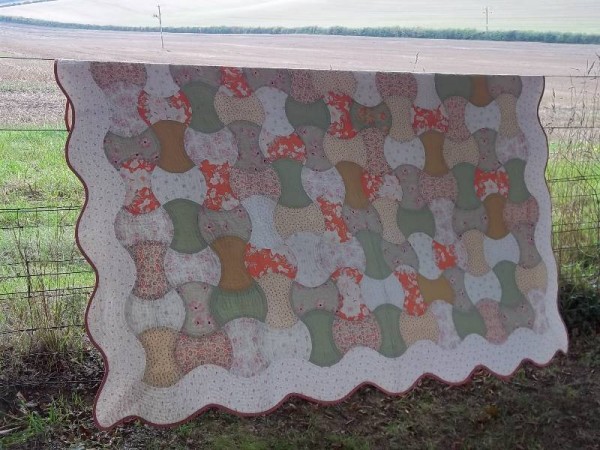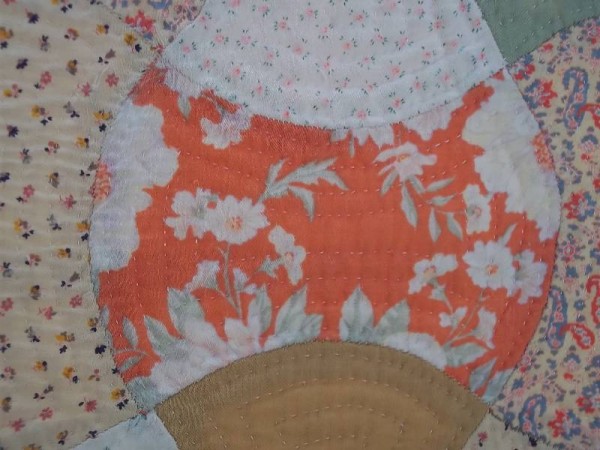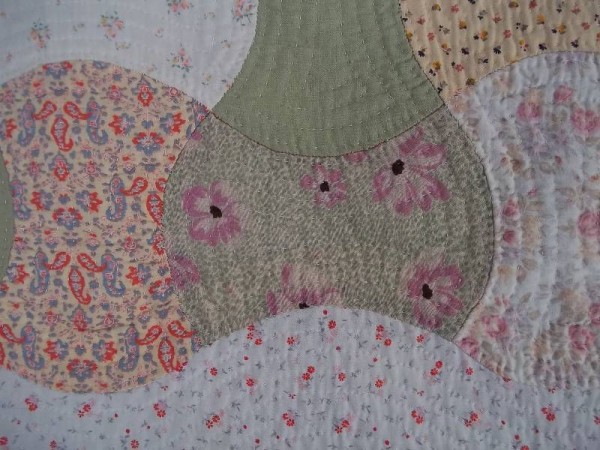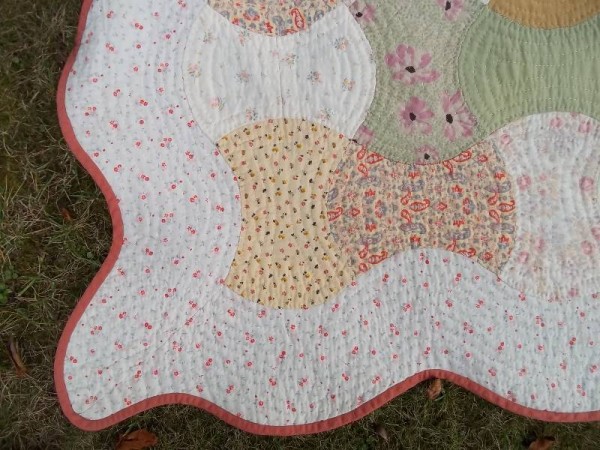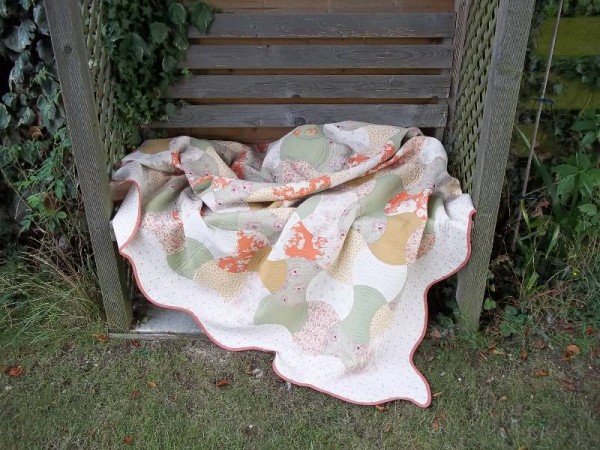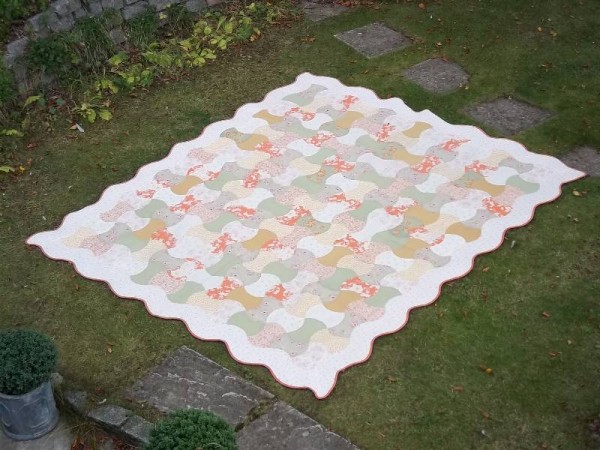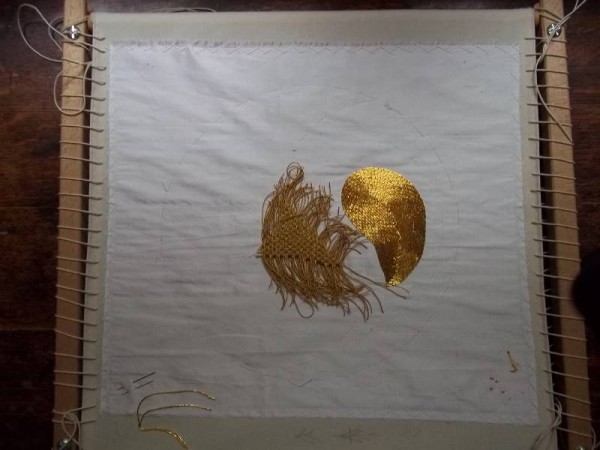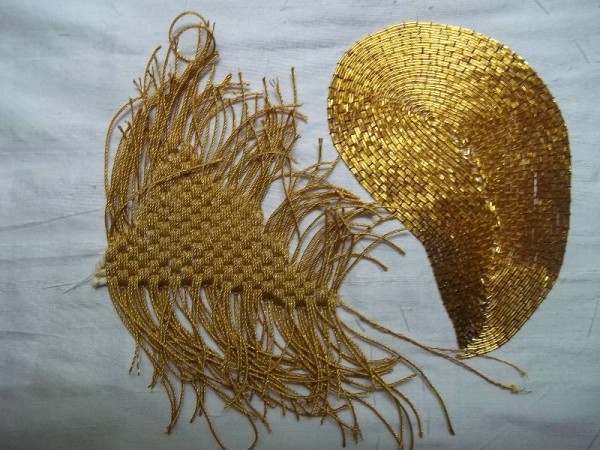A bright but blustery day with the air full of bombarding beech nuts I braved the latter and took advantage of the comparative warmth to photograph this quilt on the fence at the end of the garden. Although not old as quilts go, it had been a material witness to the early life of my 4 children and regular washing had taken its toll. Though soft and muted there’s a definite worn look when viewed close to and its deterioration made me realise that viyella and fine wools were not ideal for quilts that had to cope with the multifarious common assaults that children, especially young ones, visit on bed coverings. I had thought I wouldn’t even blog it as I was rather upset at its deterioration, fading, discolouration, etc. from its initial beauty. However, as it sat on a chest in the corner of a room all of a sudden the loud though passive accusal of neglect became just too great to ignore. As in photographs it still looks rather good, I decided I should celebrate its faded loveliness and enjoy the memories that the various fabrics had to offer.
The coral floral fabric, the pale green and the mustard fabrics shown above were all bought specifically for the quilt to add colour. Small prints came from the making of little dresses for toddlers, while the green splodgy fabric with mauve flowers was a Liberty Varuna pure wool fabric that had been a maternity dress. The paisley with the yellow background had formed a contrasting hem band to a blue floral dress in a way that would have sounded ghastly a year or so ago but which would now look pretty fashionable. Plus ça change, etc.
I bought lots of the little floral prints in sales to make nighties for growing children and for backing numerous planned quilts – in the picture above you can see 3 of these. I quilted the whole thing in lines of stitching which echo the quilt pieces and bound it in bias strips cut from a piece of coral viyella.
This design is also known as apple core in the U.S. I’m surprised at how few people make it as it is a quilt that grows quickly in the making and offers easy quilting either in overlapping circles or waves. It does, however, require quite big individual pieces of fabric, so little scraps are no good at all.
In the photograph at the head of this blog, beyond and to the side of the quilt you can glimpse the field behind the house. We are very ‘green’ in these parts – sometimes it might seem a bit too green. Coming back from work on Monday evening our nostrils were assailed with a new pungent odour which increased as we neared the vicarage. Later in the evening, the PCC treasurer who is also the wife of a local farmer, dropped by the vicarage on church matters so we waved vague questioning fingers in the air around us and asked if this was her husband’s doing. With her finely attuned sense of smell she protested that it wasn’t their smell and obviously felt strong enough about the misattribution to email later in the evening with the information that it was the work of another farmer (and emeritus Church Warden) who had spread ‘that stuff from Benson’ on to the field behind us.
So in some St Mary Mead style sleuthing, I emailed the relevant farmer asking if he were putting on ‘our’ field the product of the organic waste from our little green bins. In reply, I received the following information which is rather interesting and which I should probably have already gleaned from a more in depth reading of the local paper.
The anaerobic digester at Benson, which I pass twice a day on my way to and from Oxford, consists of an inoffensive series of low lying round green buildings with gently sloping conical roofs. It begin operation in November 2012 and despite initial objections as to a potential smell, I have never noticed anything unpleasant. This plant takes all the household compost of South and West Oxfordshire, i.e. organic kitchen waste that we put the little green bins. Some farmers take this when processed though as yet I’m not clear quite how they use it. Processing of this also puts methane into the grid. But it was not this on our field.
A separate processing plant on the same site takes grass cuttings and hedge clippings and it is this which has been spread on the field behind us. This will apparently be disked in (I’ve no idea what that means – I shall find out) soon and the ground will then be left until the legal date of February 14 before it is further disturbed or treated with herbicides, etc. In this way the land will be left as food for songbirds, for the growth of weeds and for the proliferation of bugs through the “hungry gap” (I’m asking about that too). Poppies will be planted in late March. The stuff on the field now should not smell – “though it might a bit to start with” – which it does, but it’s certainly not unbearable nor is it as bad as I remember the smell of chicken litter on the fields from my days in Nottinghamshire. So, now I’m a bit clearer both about what’s happening in the field and what is going on at Benson and I feel I can relax and get on with enjoying the view. The only dark cloud is that we shall soon be allowing out our newly spayed year-old kitten. I blanche at the thought of a meadow full of baby songbirds. As yet she scarcely puts her nose out of the door and anyway it’s not the time of year for baby birds. But by spring I shall have to source an industrial bell for her collar – one that is light but very noisy. I’m also keeping my fingers crossed that she will still find the big outdoors too intimidating – a vain hope, I fear.
Postscript: Many thanks must go to Jane Brocket for the lovely things she said about me and my blog yesterday. Her book “The Gentle Art of Domesticity” motivated me to get blogging in the first place. Her beautiful photographs of things as diverse as quilts, cakes, paintings/prints, marble floors and balls of wool and her interesting and informed text showed blogging at its liberating and stimulating best and filled me with a burning desire to get blogging too. Even if no one reads my blog, I’d still do it, as family, friends and parishioners do dip in from time to time to see what’s going on. That more people are now coming to my blog through Jane is immeasurably exciting. Thank you Jane.

